This article looks at how we can stop the cider-making process one stage earlier to make apple juice.
Apple Juice
Apple juice is in some ways more difficult to make than cider, and indeed it can scarcely be regarded as a traditional product at all. Until the recognition late in the 19th century that fermentation was caused by yeast converting sugar into alcohol, the difference between juice and cider was somewhat obscure and of little practical importance in any case. Not until the invention of pasteurisation was there any practical way of preserving the juice with its full content of sugar. That is the fundamental process of juice-making – to preserve the sugar from the fruit without it turning into alcohol – and this can really only be done by heat treatment to kill the yeasts, or by deep-freezing or chemical additions to stop them growing. All these processes require a relatively sophisticated technology by traditional standards.
The milling and pressing requirements for juice making are no different from cider making, since both begin at the same point. The fruit requirements, however, are rather different. In cider we need high sugar to turn into alcohol, some acid to benefit the course of fermentation and some tannin to give body to the final blend. In juice the most important feature is the ‘Brix/acid’ ratio, which is the percentage sugar divided by the percentage acid. In the UK and the rest of Northern Europe, a ratio of 15 – 20 would be considered appropriate. In the USA, ratios as high as 30 are acceptable, but the juices would be considered very sweet to a British palate. Up to a point, the absolute values of sugar and acid do not matter so much as the ratio. Thus, a juice with 10% sugar and 0.5% acid would be equally as acceptable as a juice with 15% sugar and 0.75% acid, both having a ratio of 20. From this, it is easy to see that a Bramley juice with 10% sugar and 1% acid gives an unacceptably low ratio of 10, while a sweet cider cultivar with sugar of 15% and acid of 0.2% would have an unacceptably high ratio of 75. A bittersweet cider cultivar, with high tannin levels too, would also be quite inappropriate for juice making.

In practice, good juices can be made from a variety of dessert apples, and those which have interesting flavours in their own right (e.g. Cox or Russett) generally make interesting juices too. Apples which are delicate in flavour, such as Worcester Pearmain, make rather flavourless juices. Sweet apples can always be blended with Bramley to improve their acidity, while Bramley itself can always have some sugar added to improve its B/A ratio even though it will never make a first class juice. A good general starting point is three parts dessert apple to one part Bramley. Although the fruit must be clean and wholesome it can be small or misshapen. Indeed most commercial apple juice is made from such fruit which is cosmetically unsaleable on the retail market. But the fruit must be well-washed and NONE OF IT MUST BE MOULDY! If you wouldn’t be prepared to eat it as fresh fruit, then it’s not fit for juice-making!

Cloudy ‘fresh’ juice
One of the best juices to make, if we are going to the trouble of making apple juice at all, is the pale cloudy juice which has become very popular in the UK in recent years. (Curiously, the basic process was developed in the USA and Canada but it is scarcely used there at all at present). The fruit is chosen, washed, sorted, milled and quickly pressed – fruit blending has to take place before pressing. After screening through a coarse mesh, Vitamin C (ascorbic acid) is added directly to the juice at the rate of 500 parts per million (5 g per 10 litres of juice). Pure powdered ascorbic acid should be used for this – it will be much cheaper and more convenient as a winemaking sundry than as a formulated vitamin from the chemist shop. The ascorbic acid allows certain oxidation reactions to happen in the juice which develop its flavour, but it prevents the browning of the tannins which make it look unsightly and lead to sedimentation.
Now the juice must be preserved without delay. If you have room in your freezer, it can be poured into plastic containers, or into polythene bags packed into cardboard shells. Once frozen, the juice can be withdrawn from the cardboard and stored as frozen polythene bricks. The juice can be thawed for use as required, but it will not keep long after thawing, because the enzymes and yeasts that were present in the juice originally will still be active. Nor will the cloud be ‘set’ and it may settle out rapidly when thawed. However, freezing is very convenient if you have the space to cope with it.

Pasteurisation
The alternative is pasteurisation. For this, the juice must be run into Kilner jars or good quality glass bottles (not plastic!) which can be sterile sealed by heating. Crown capped beer bottles, available from home brewing suppliers, will do quite well, as will good quality screw-capped bottles. The bottles or jars are filled to within an inch of the top and placed in a large pan of water which is put on the stove and gently warmed. The bottles should be as far immersed in the water as possible. Using a thermometer, bring the water up to 77° C and hold it at that temperature for 30 mins. Alternatively, place the thermometer in the centre bottle of the group and continue heating until the temperature of that juice itself reaches at least 74° C. At this temperature, all the yeasts should be destroyed. Take the hot bottles out of the pan and cap them immediately. Do not stand the hot bottles on a cold metal surface or the cold shock may crack them. If using Kilner jars, follow the usual procedure to obtain a sterile vacuum seal. If using beer or screw-cap bottles, seal them tightly and then lay them on their sides to cool slowly, so that the hot juice can sterilise the inside of the cap. Do not hurry the cooling process. Next day, the bottles may be stored at room temperature indefinitely until required, although the juice itself always tastes best if chilled for a few hours before drinking.
Heat treatment of this sort is very satisfactory although the occasional broken bottle may result during pasteurisation. Mould growth very occasionally occurs in the bottles during storage because mould spores can be extremely heat resistant although yeasts are quite easily killed. An advantage of heat treatment is that it actually ‘sets’ and stabilises most of the desirable apple juice cloud, which does not happen when the juices are frozen. On a large scale, purpose built pasteurisers may be purchased, or a handy person can convert a stainless steel sink with an immersion heater and a false bottom to maintain the correct temperature. Bulk pasteurisation of the juice itself in a tank or a saucepan is a poor alternative to in-bottle pasteurisation, because of the danger of overheating and excessive oxidation, and it is difficult to hot-fill the bottles aseptically on a small scale. Commercially, flow-through heat exchangers are used and the hot juice is filled straight into clean warm bottles.

Clear Juice
To make a clear golden juice it is necessary to destroy the pectin cloud and to allow a certain amount of oxidation for colour development. The most reliable way of doing this is to press out the juice as normal into a clean container, without the addition of any ascorbic acid. Add a pectolytic enzyme and keep the juice cool overnight to prevent yeast growth and fermentation. Next morning, the juice should be golden in colour and should have dropped bright, leaving a sediment at the bottom. If not, it may have to be fined with gelatin/bentonite (see Part 5) and left cool for a further day. Rack or strain the juice carefully into clean containers for preservation by freezing or by heat treatment as described in the previous section. Sometimes the colour becomes rather dark by this method, and a small amount of ascorbic acid (100 – 250 ppm) may therefore be added before enzyming to inhibit oxidation. In some cases the addition of pectic enzyme may be unnecessary since there may be sufficient enzyme and calcium present naturally in the juice for it to ‘drop bright’ by itself overnight in the cold – but you will not know this until you try it!.
WARNING
JUICES MUST NEVER BE BOTTLED (ESPECIALLY IN GLASS) WITHOUT EFFECTIVE PASTEURISATION ! If all the juice sugar ferments inside a closed bottle, it can theoretically develop an internal pressure in excess of 400 p.s.i. (pounds per square inch). This is more than enough to cause serious damage or injury when the bottle eventually explodes (as it almost certainly will). Just for comparison, even a properly designed champagne bottle is only expected to hold a pressure of about 100 p.s.i.

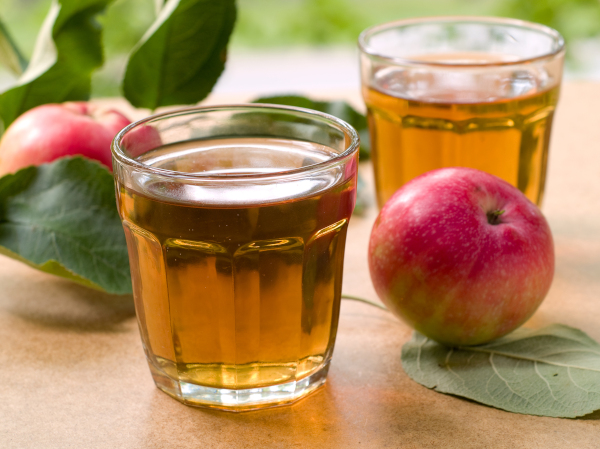

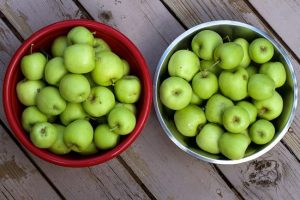
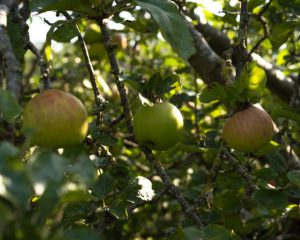
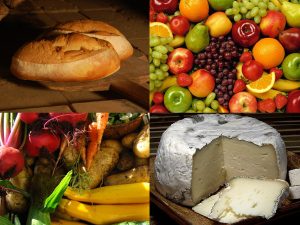
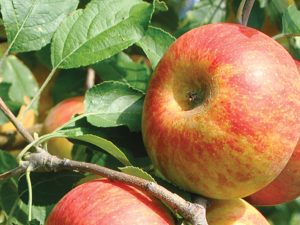
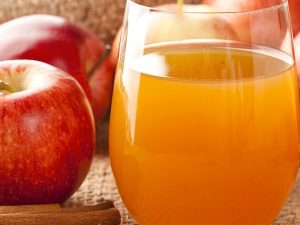
4 Comments
I have one of those Mehu-Maija hot juicers- I never could have afforded it new; but this one was in the Oxfam shop in Edgware, where I had some work. I had to carry it home in a black bin bag on the Tube; and got some funny looks.But it is a really good thing. You put the apples in the top section, water in the bottom and heat it. The apples cook and collapse; and the juice runs hot into the middle section. From there you run it through a tube into your screw- topped bottles. This juice is now pasteurised. You close the bottles while it is all still hot; and the juice will keep for years. It’s a really quick way to deal with a lot of apples; and gives you nice juice to keep till needed or to take round to friends. Remaining pulp can be made into fruit cheese, fed to pigs, etc.
Hi, is it really possible to keep the cloudy juice as beautifully light in color as in the picture only by adding ascorbic acid *after* pressing. When I make juice, the apple pieces are quite brown already after milling, and when I have finally (as I learned from Andrew Leah’s craft cider book) built them into a pile of “cheeses” and pressed them with a hydraulic jack and wooden frame, the juice that comes out has about the color of the “clear apple juice” picture. That is, rather more brown than yellow. How is it possible to be fast enough so that browning hasn’t already happened when the juice leaves the press?
Yes it is quite possible, Browning does happen during milling and pressing indeed (also some desirable aroma development). Chemically, the colourless polyphenols are enzymically oxidised to coloured quinones, but they are reduced back to colourless polyphenols when the ascorbic acid is added. However, it’s important that this addition is done as soon after pressing as possible (within hours) and that the pasteurisation also is done within the same timescale, Otherwise the enzymic oxidation will continue and the juice will continue to brown. Likewise it is necessary to use the full amount of ascorbic recommended (500 ppm) and no less.
That explains it! Many thanks for your helpfulness, and sorry for misspelling your name.